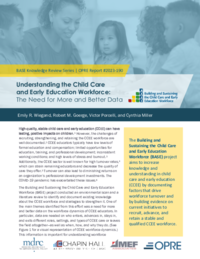Understanding the Child Care and Early Education Workforce
The Need for More and Better Data

The Building and Sustaining the Child Care and Early Education Workforce project aims to increase knowledge and understanding about child care and early education (CCEE) by documenting factors that drive turnover and by building evidence on current initiatives to bolster a qualified CCEE workforce. As part of the project, researchers identified a need for more and better data on which individuals enter, advance in, stay in, and exit different roles, settings, and types of CCEE care or leave the field altogether—as well as when, how, and why they do. This information is important for informing the development, evaluation, and improvement of strategies that effectively build and sustain a qualified and stable CCEE workforce. For this reason, the BASE project team conducted a data scan to summarize the landscape of existing data sources that may address these gaps and identify areas where future data collection may be most useful.
This brief summarizes the findings from the data scan, which include the following findings:
- Data sources were identified that could be used to address knowledge gaps about CCEE workforce dynamics, including national surveys, state and local surveys, state workforce registries, unemployment insurance wage data, Quality Rating and Improvement System data, program data, policy databases, and integrated (linked) data sources.
- Two key gaps that were identified are data sources that track educators’ movement—whether across states, industries, or roles—and data sources that capture data on the same educators over time.
- Data linkage may be a promising method to achieve a comprehensive dataset (such as one from state integrated data sources) that can answer research questions about workforce dynamics.
- Some populations are particularly underrepresented in the data landscape (for example, home-based child care settings and providers).
Document Details
Wiegand, Goerge, Porcelli, and Miller (2024). Understanding the Child Care and Early Education Workforce: The Need for More and Better Data OPRE Report 2023-190. Washington, DC: Office of Planning, Research, and Evaluation, Administration for Children and Families, U.S. Department of Health and Human Services. Available at: https://www.acf.hhs.gov/opre/project/building-and-sustaining-early-care…






